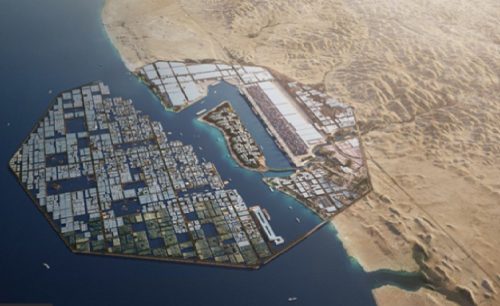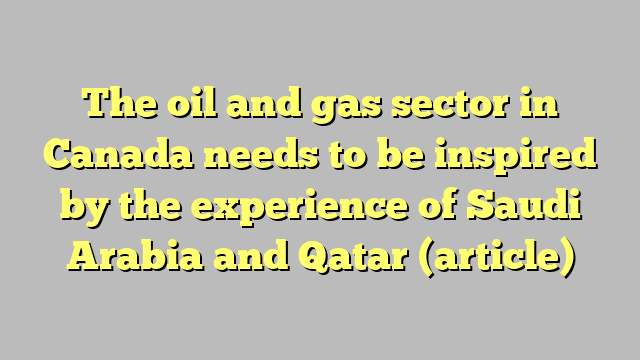Read in this article
- Qatar has grown its GDP 10 times in just 20 years
- Western government officials often talk about “just transitions,” emissions caps, and the end of oil
- Middle East ministers talk about energy diversification and circular carbon economics
- Like Canada, Qatar and Saudi Arabia want to develop their economies and improve the standard of living of their citizens
- There is a positive long-term outlook for demand for oil and natural gas
When I visited the Qatari capital, Doha, a question came to my mind about supporting the oil and gas sector in Canada, just like Saudi Arabia, Qatar and other Middle Eastern countries.
The government is now preparing to publish details of its long-term vision for the oil and gas sector in Canada, which affects 202,000 workers and investors alike.
While driving around the streets of Doha, the capital of Qatar, soon to be the world’s largest exporter of LNG, I thought of the phrase “there has never been such a strong business case for LNG”.
For a country that struggled to survive economically for 60 years after the collapse of the pearl diving industry in the 1940s, developments in Qatar today are remarkable.
In just 20 years, thanks to its vast reserves of natural gas and its ability to market it by liquefaction, Qatar has grown its GDP 10 times.
It should be noted that Qatar has accumulated a sovereign wealth fund of more than $450 billion, and has used the liquefied gas revenues to build its brand and build new cities with infrastructure that the world, or at least most Western countries, would like to own.

Employment of resources in development
Instead of blaming the oil and gas sectors, Qatar, Saudi Arabia and some countries in the Middle East are supporting and strengthening them, using their wealth of resources to develop their economies, diversifying slowly from hydrocarbons and expanding investment in alternative energy.
A question worth asking is whether Canada and the environment might be better off adopting a similar all-in-one strategy rather than its current selective approach.
In mid-January, I visited the Middle East for the first time and had the opportunity to meet many government ministers, including the Qatari Minister of Energy, Eng. Saad bin Sherida Al-Kaabi, and the Saudi Minister of Energy, Prince Abdulaziz bin Salman.
It found that the ambition of the long-term and pragmatic energy-related visions put forward by the two ministers contrasts greatly with the aspirations of Western countries.
Western government officials often talk about “just transitions,” emissions caps and the end of oil, while Middle Eastern ministers talk about diversification of energy sources, circular carbon economies and the fundamental need to increase oil and natural gas production in order to meet the demands of a growing world population.
In light of this, you can’t help but be drawn to the ministers’ enthusiasm when you hear how oil and natural gas revenues will allow entire economies to transform over time.
For example, Saudi Arabia is building a 170-kilometre city, home to 9 million people, powered entirely by renewable energy in the now arid desert, and funded entirely by revenue from the sale of oil.
The project is just one of 15 active megaprojects in the country, all funded by hydrocarbon revenues.
And I wonder, here, when was the last time you heard about some bold infrastructure project in Canada or the United States or Europe?
Like Canada, Qatar and Saudi Arabia want to grow their economies, improve the standard of living of their citizens, and eventually diversify their economies by largely eliminating hydrocarbon production.
alternative energy sources
Despite being major producers of hydrocarbons, Saudi Arabia and Qatar focus on the long-term need to build an energy mix that includes more alternative energy.
Saudi Arabia, the world’s second largest oil producer, aims to obtain 45-50% of its energy mix from renewable energy by 2030, although the methodology for achieving these goals is fundamentally different.
Perhaps this is due to the Middle East’s geographic proximity to China and India, both of which have a population of 1.4 billion, which gives them a better global perspective on the potential long-term structural growth in demand for hydrocarbons.
It may be that there are no 4-year electoral cycles that better allow for long-term strategic planning, and that there is no need to use the oil and gas sector as a political divisive issue.

Canada’s need for realpolitik
The Ottawa government’s long-term vision for Canada’s oil and gas sector could use at least some of the energy realism of Saudi Arabia and Qatar.
With the population growth of more than a billion people over the coming years in regions of the world that seek to achieve a very high lifestyle based on hydrocarbon intensity, there is a positive long-term outlook for the demand for oil and natural gas.
Oil and natural gas will be essential for many decades to come, even with global energy transitions.
In light of the trends to convert all 1.5 billion internal combustion engine cars to electricity, displacing 27% of the total oil consumption, there is an urgent need to explore for energy minerals, such as copper, graphite, nickel and cobalt, which is an oil-intensive process.
To meet ambitious government goals for electric cars, the world will need to extract the same amount of copper over the next 20 years that has been mined since the dawn of time.
Moreover, according to retired miner John Pettimore, each 1,000-pound (453.59-kilogram) electric car battery means mining 90,000 pounds (40.82 tons) of ore, which would require the energy equivalent of 100 barrels of oil for a battery that stores the equivalent energy One barrel of oil equivalent, and it is clear that demand for oil will not peak anytime soon, even as governments seek to decarbonise.
It is worth noting that any market share that Canada voluntarily gives up will be happily assumed by others to fall under less stringent environmental standards, and that anyone whose child has had to wait 9 hours in the emergency room to see a doctor knows we can do better as a country.
We could ask why Qatar, the country that has embraced the LNG industry, has almost 3 times as many doctors per capita as Canada!
And we can do it all: Increase oil and gas production in Canada, to the highest environmental standards anywhere in the world, allowing us to help meet the world’s needs while benefiting from its revenues and allowing for significant additional investment in our national infrastructure.
This will allow Canada to increase environmental initiatives such as carbon capture and storage.
My tour in Doha made me believe that Canada can benefit from the pioneering experiences and qualitative developments that Qatar and Saudi Arabia are witnessing.
* Eric Nuttall – Writer specializing in investment strategies.
Note: This article was originally published in the Financial Post and is republished with the author’s permission.
Also read..

Leave a Reply